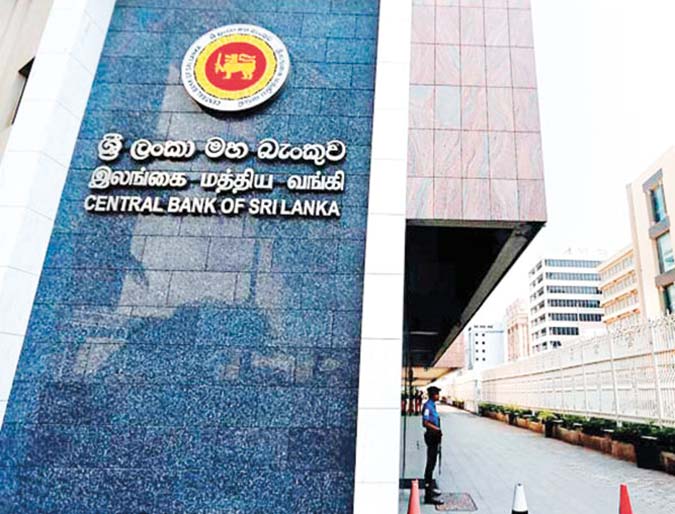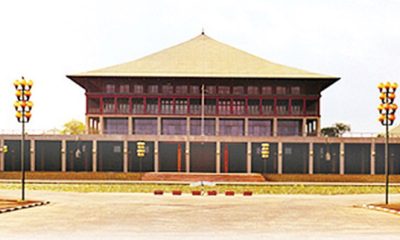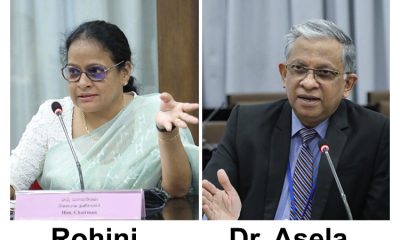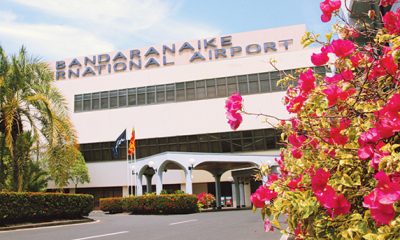Features
Domestic Debt Restructuring – An Alternate View

by Romesh Bandaranaike, Ph.D.
There have been substantial and wide spread criticisms of the recently instituted Domestic Debt Restructuring (DDR) scheme carried out by Central Bank of Sri Lanka (CBSL), to reduce the Sri Lanka Government’s requirements for funding. In this article I argue that the scheme, as structured and carried out by CBSL, is appropriate, given the ground realities in the country, and that the critics have ignored a number of factors which forced CBSL to design the scheme as it did. I then suggest additional steps the Government could take to further improve its financial position in connection with past Bond issues.
The DDR Scheme
Faced with massive shortfalls in revenue, the Government recently carried out a “restructuring” of the debts it owed on Sri Lanka Rupee denominated Treasury Bills and Bonds in an effort to substantially improve Government finances, including the funds needed to service these Bills/Bonds. The two key elements of the DDR are a) Converting all Treasury Bills presently owned by CBSL to longer term Treasury Bonds, thereby substantially delaying the payment dates on these Bills; and b) Effectively “forcing” the Employees Provident Fund (EPF) and other superannuation funds to exchange most of the Bonds they hold for 12 year Bonds with somewhat lower interest payments.
They did this by threatening to increase the tax rates that EPF pays on its annual income to 30% from the present 14%, if they did not accept the Bond exchange. Since such an increase was financially worse for EPF compared with the Bond exchange, EPF opted for the latter.
CBSL estimates that the scheme would reduce the Gross Financing Needs (GFN) of the Government by 1.5%, 1% by the CBSL Bill-Bond exchange and 0.5% by the EPF Bond exchange.
The Criticisms
The principal criticisms of the DDR, from the public, Trade Unions, Economic Think Tanks, and numerous “Experts,” is that the entire burden of the DDR is being placed on the backs of the retirement savings of “poor workers” who are the members of EPF.
CBSL has justified the proposed increase in the tax rates for EPF and other superannuation funds to 30% from the present 14% on the basis that the banks have to pay the higher tax rate of 30% plus VAT. Dr. Wijewardena, a former CBSL Deputy Governor, has written several articles criticizing CBSL for not presenting the correct picture in this regard and not disclosing full information on the impacts of the restructuring on EPF members’ returns. Dr. W’s main argument is that, in the case of the banks, the tax rate applies to “net interest”, whereas, in the case of the EPF, it applies to “gross interest.” For the banks, net interest is interest earnings on its loans less the interest it pays to depositors.
In the case of EPF, Dr. W points out that EPF is not allowed to subtract the interest it pays to EPF account holders to determine its income and tax liability, and that CBSL comparison of bank and EPF tax rates is therefore misleading. In a subsequent article by Dr. W, he criticizes CBSL/EPF for not fully disclosing the cost to EPF holders of accepting the proposed DDR compared with an increase in EPF’s tax rate to 30% and the justification for accepting the Bond exchange rather than the tax increase to 30%. He goes on to add that CBSL has a conflict of interest as both the developer of Government policy and as the administrator of EPF.
My Responses to the Criticisms
The criticism that the entire burden of the DDR is on the backs of workers is factually incorrect. As stated above, two-third of the 1.5% reduction in GFN (1%) is being achieved by exchanging the Treasury Bills held by CBSL for long term Bonds. Only 0.5% of the reduction is from the exchange of Bonds held by the EPF and other superannuation funds. In other words, 67% of the restructuring cost is borne by CBSL (in effect by all citizens), while only 33% is borne by EPF account holders. Furthermore, only workers in the formal private sector contribute to the EPF/ETF, while workers in the informal private sector (e.g. farmers, fishermen, small transporters, traders and construction workers) and Government employees do not.
As a result, only about 25-30% of the workers in the country have EPF accounts. Therefore, 70-75% of workers in the country will not suffer any burden due to the EPF bond restructuring. Finally, the workers with EPF accounts also include middle and senior management of companies who cannot be called “poor workers” as referred to in the various criticisms of the present DDR scheme. It is true that this category may only be a very small percentage of those holding EPF accounts. However, their account balances are likely to be very much higher than other EPF members and the impact of the restructuring on them will be proportional to these balances.
It would be ideal if the EPF could release statistics in this regard which will allow an assessment of this element. For example, the fraction of the total EPF funds held by those with EPF balances of over Rs 5 million (say), since such persons cannot be classified as “poor workers.” Workers who have balances in EPF/ETF, built up as a result of deductions from their salaries and additional higher contributions from their employers, at least have a retirement fund they can turn to, even if it is somewhat less because of the DDR. It could conceivably be argued that the 70-75% of workers who do not have such balances, mostly working in the informal sector, are worse off or poorer than those with EPF balances. This would be a justification for placing the burden of part of the DDR on EPF account holders rather than on other, even “poorer”, workers.
In response to Dr. W’s criticisms that EPF and bank tax rates are not comparable the way CBSL has done; each year, EPF determines a percentage it will pay/accrue to the account of each EPF account holder based on the earnings by the EPF that year. This percentage is not an interest similar to that paid by banks to its depositors and is not a cost that is deductible by EPF to calculate its tax liability each year. It is simply a percentage decided by the EPF administrators to allocate the profits after tax earned by the EPF during the year. Calling this percentage an “interest” is a misnomer. Account holders in EPF are akin to shareholders in banks and not depositors.
The amounts credited by EPF to a member’s account each year, based on EPF’s earnings during the year, is not a cost incurred by EPF in generating these earnings. It is something closer to a dividend paid by a bank to its shareholders in the form of additional shares. If EPF is allowed to determine its tax liabilities by subtracting these accrued amounts, banks should be able to deduct dividend costs in determining their tax liabilities. Dr. W’s criticism of the non-comparability of bank and EPF tax rates cannot be sustained.
Dr. W uses CBSL/EPF’s own numbers on the differences in returns under the two scenarios EPF has been offered and simply multiplies it by the total EPF Bond holding value to arrive at the cost to EPF of accepting the Bond exchange. This is something that could have readily been done by anyone and Dr. W’s implication that CBSL/EPF is hiding/not fully disclosing something in its statement cannot be sustained.
The CBSL/EPF analysis is simply to show that the return to EPF is better under the scenario where it accepts the DDR option, compared to rejecting the DDR option and being subject to a 30% tax rate. This information is more than sufficient for EPF to recommend to its Board that it should accept the DDR. Dr. W than goes into the past history of taxation rates applicable to the EPF and points out that as originally envisaged EPF earnings were to be tax exempt.
He shows calculations of the losses to EPF holders of the present DDR, compared with a situation if EPF earnings were tax exempt. This is a straw man put up by Dr. W to be knocked down as part of his criticism of CBSL/EPF. It is the tax rates that are applicable to EPF today, before the DDR, that are relevant and it would have been nonsensical for CBSL to show calculations based on what if the tax rates were those that existed many years ago.
With respect to the criticism that CBSL has a conflict of interest in both being the administrator of EPF and the policy advisor recommending the DDR, I do not see any conflict. CBSL, as advisor to the Government, has made the DDR proposal which allows EPF to choose between two options, accept the proposed DDR Bond exchange or reject it and be subject to a 30% tax rate. As the administrator of the EPF, CBSL has simply analysed these two options and clearly shown that the EPF is better off accepting the Bond exchange compared with rejecting it and being subject to a 30% tax rate.
Other Relevant Issues
It is telling that none of those criticizing the present process have offered any viable alternative DDR arrangement to achieve the same objectives as the present exercise. In saying this, I am ignoring the suggestions by some parties who say there would be no need for the exercise if “The money stolen by the Rajapaksa’s is recovered” or “The large corruption in Government is reduced,” and so on. Such actions, even if they were possible, are not alternatives, because they cannot be achieved in the short or medium term, which is one of the key objectives of the DDR. Verite Research did, some time ago before the announcement of the present DDR, present some analysis on a possible DDR which included sharing the cut across all Bond holders, but, for the reasons I refer to below, this is not a viable arrangement.
CBSL in its original presentation to the Cabinet, and subsequently to the public, argued that it would be prudent to exclude the Banks from the DDR exercise, because these institutions were already under stress as a result of COVID related business failures and because the banks would also be taking a hit from the future restructuring of USD Bonds, some of which are held by them.
CBSL was of the view that such an exclusion was essential to ensure financial system stability. None of those criticizing the present DDR arrangements have objected to this and I concur with that view. Even if the banks are able to bear the burden of some restructuring of the domestic bonds they hold, bank stability is also dependent on public perception, and excluding them from the DDR has certainly had a positive impact on such perception.
There are two unstated conditions applicable to the DDR exercise which have received no mention in the ongoing discussions. First, the DDR should be concluded in a short time frame since it will be a pre-condition to the restructuring of foreign currency debt. Second, it must be carried out in a legally valid manner. A Government Bond is a legal contract between the Government and the holder of the Bond.
The Government is legally obligated to pay the interest coupon and the principal of the Bond on specified dates according to this legal contract. The Government has no legal authority to change the conditions of this Bond. It could, of course, pass a new law in Parliament giving itself the authority to make changes to existing Bonds. In doing so, however, if all Bond holders are not treated equally (in particular, if the bank holdings of Bonds are excluded), there are bound to be legal challenges in the Courts to any such changes, and the changes may well be struck down by the Courts.
Even if such changes are not struck down, this process can take considerable time to be determined and would not be achievable in the time frame required for the DDR process to be concluded as discussed previously. The present DDR has finessed the issue of different treatments of Bond holders by making it “voluntary”, albeit by holding a gun to the head of the EPF and superannuation funds in the manner detailed earlier. This is draconian, but effective.
As per CBSL statistics presented in connection with the original DDR proposal, the total outstanding amount of Treasury Bonds at that time was Rs. 8,700 billion. Of this amount Rs 1,644 billion is held by “Others”, after excluding the banks and EPF and superannuation funds being subject to the DDR. Even if the banks are excluded from the DDR to ensure “financial system stability” reasons mentioned previously, it would have been ideal if the “Others” holding the Rs 1,644 billion in outstanding Bonds were subject to some “restructuring”, in the form of cuts in coupon rates and/or face value, or an extension of the tenor of these Bonds.
If this was done, the benefit of these cuts could have been passed on in the form of a reduction in the burden passed onto EPF and superannuation funds. However, such an unequal treatment where some Bond holders (the banks) are excluded, even if the necessary legislation is passed, would certainly have resulted in legal challenges which would, at the least, have delayed the process as I have pointed out earlier, or even been found unconstitutional by the Courts.
Further Actions in Respect of Bonds
Very high yield rate Bonds (over 20% yield) were issued by the Government during the period prior to the announcement of the DDR (April 8, 2022 to March 13, 2023) as a consequence of severe financial shortages faced by the Government. Bidders for these Bonds added a premium to the bid yield rates, expecting a future restructuring of these Bonds as part of the DDR they knew was coming. By being excluded from the DDR, these Bond holders have enjoyed a “windfall profit.” It is not possible to specifically target these Bonds for a cut in coupons or face value, because many of the original holders may have sold some of these Bonds and have already earned the windfall profits.
[The buyers of the Bonds would only receive a “normal” profit in the form of coupon payments and final redemption.] Furthermore, in the case of individual Bond holders, their windfall profit would be in the form of a capital gain, which only attracts a tax rate of 10%. Corporates/ banks in the same situation would be paying a tax of 30% on their capital gains. I propose that the Government should “claw back” some of these profits by imposing a special windfall tax rate of 50% applicable to all profits derived from these Bonds. If the original purchaser has not sold the Bonds, the coupon interest and the capital gains on final face value redemption should also be taxed at 50%.
There would be some complications in structuring this tax, since some high yield Bonds may have changed hands within the period that high yield Bonds were still being issued, which means that the initial purchaser would only have made a small capital gain and the next buyer would still be enjoying the high coupon rate or subsequently selling the Bond for a large capital gain. A proper structuring of the 50% windfall tax can ensure that the taxes fall on those making the windfall profits. A tax of the type proposed will clearly be borne by the wealthy, who would have been the purchasers of these Bonds, and go some way towards balancing the burden imposed on less wealthy parties as a result of the DDR.
To place this suggestion in perspective, between April 8, 2022 and March 13, 2023 all Bonds issued by CBSL had yield rates in excess of 20%. The total face value of such Bonds was Rs 1,233 billion. The weighted average yield on these Bonds was 27.89% and the weighted average coupons in these Bonds was 19.09%. The latest four-year Bond yield rate is approximately 15% and this is likely to drop further.
As a result, any seller today of an average high yield Bond would make a significant capital gain on the sale and would need to pay substantial taxes to the Government at the proposed 50% windfall tax rate. As per CBSL statistics in the original CBSL presentation to the Cabinet, approximately 63.5% of all Bonds at that time were held by the banks and the “Other” category. If this percentage is also applicable to the high yield Bonds referred to above, the banks and the “Other” category would be holding Rs 777 billion of these Bonds.
Advocata has recently analysed EPF’s Bond portfolio prior to the DDR Bond exchange and concluded that EPF’s share of high yield Bonds was proportionately much less than for other Bond holders. Therefore, banks and “Others” would probably be holding even more than the above mentioned Rs 777 billion in such high yield Bonds which, in turn, will mean that a 50% windfall tax on the profits from these Bonds will result in substantial tax revenues for the Government.
An aside at this point is that for some unclear reason there is no withholding tax (WHT) applied to the interest earnings on Bonds as in the case of interest earnings from deposits in banks and finance companies. I have made inquiries as to why this is so from several senior Government officials and have not received any explanation for the practice.
It may well be that some Bond holders do not even have income tax files and that they are evading all taxes payable on Bond interest. Since Bond holders are all likely to be at the highest tax bracket given the minimum sizes of Bond investments, I suggest that a WHT of 30% be applied to all Bond interest payments. Holders are free to file tax returns and seek a refund if they have been taxed in excess of their liability due to such a WHT. I have been told there is some complication in applying WHT to Bond interest held by foreigners. If that is indeed the case, foreign holdings of Bonds could be excluded.
Conclusions
The economy of the country is in dire straits as a result primarily of bad/foolish policies of recent past Governments (including those by CBSL under its previous two Governors and Monetary Boards at that time) coupled with the endemic corruption inherent in the system. The present Governor of CBSL and his professional colleagues are facing very difficult conditions and are striving to get the country’s finances back on track.
I can understand trade unions, workers and other similar entities objecting to the implementation of policies which directly impact them, irrespective of whether such policies are needed to solve the country’s issues. But, why is it that so called “experts” and think tanks do not recognize the ground realities of what is practically achievable and support the efforts of CBSL rather than criticizing these efforts in print and at discussion forums?
(The author is an economist with wide experience in policy formulation and implementation in the Ministry of Finance and has worked at CEO level in both public and private sectors.
Features
Tree planting along road reservations and banks of streams

Reservations of Roads & Natural Streams which extend to about 10 to 20 on either side are not actively protected in Sri Lanka though it is very common in other countries. Those reservations are owned by the government. Therefore, public use of this land can be considered as a fair use of the land. Main purpose of this proposal is to introduce an intervention to connect the Forest Patches in urban areas such as Gampaha using the reservations of roads and natural streams, by planting trees so that those strips could also act as Urban Bio Corridors while enhancing the tree cover at national level. These trees also absorb the fumes emitted by vehicles while addressing global warming caused due to lack of tree cover. It also serves as a roof top for pedestrians who use reservations along public roads while adding aesthetic value to the area. Enhancing the community awareness about BioDiversity of Sri Lanka and the importance of maintaining a clean environment along road reservations is also another objective of this type of intervention. This intervention also addresses the needs of all sectors of the local communities.
Concept
The Green Road is a relatively new concept for roadway design that integrates transportation functionality and ecological sustainability. This project addresses the transport sector also because it facilitates Environmentally Sustainable Transport (EST) for local people. Therefore, Provincial Road Development Authority (PRDA) is the ideal institute to implement this project. It is also possible to introduce cycle tracks along stream banks as short cuts by improving the banks of natural streams as roads. This intervention would reduce vehicle congestion in main public roads while supporting Clean Sri Lanka programme because local communities themselves become watch dogs against culprits who pollute road reservations and water bodies of natural streams.
Already implemented projects in Mahaweli Areas
In Sri Lanka, the concept of Bio Corridor was introduced in 1988 under a Project called Mahaweli Agriculture and Rural Development project implemented in System B under an USAID funded programme. Similar to highways which connect main cities, in this case the Bio Corridors were introduced as “Bio Highways” connecting fragmented forest patches (“Bio Cities”) in paddy field areas. At the same time those corridors were improved as Cycle Tracks for the local farmers.
Figure 1 indicates the present status of a tree plantation programme implemented in Mahaweli Area (Thambuttegama) in the 1980s along newly introduced roads.
Past Experience of PRDA (WP) related to similar interventions
In 2010, similar intervention was introduced in Gampaha District in parallel with a flood mitigation project implemented by the Provincial Road Development Authority (WP). For example, while Uruwal Oya running adjacent to Gampaha Urban Area was improved to mitigate floods, riparian tree belt areas were also introduced. Later, parts of that stream running adjacent to Gampaha Town were improved as Recreational purposes such as jogging tracks for urban communities. As an additional benefit, it was expected that the shades provided by riparian tree cover would discourage growth of invasive plants such as Japan Jabara, which clogs the drainage outlets resulting in floods in urban areas.
by Eng. Mahinda Panapitiya
Features
Has Compass lost direction?

Sri Lankan voters have excelled in the art of changing governments in executioner style, which they did in many elections including that of 1977,1994, 2015, 2019 and, of course, 2024. They did so, giving massive majorities to parties in opposition that had only a few seats, because the preceding governments were so unpopular. It invariably was a negative vote, not a positive vote-endorsing policies, if any, of the incoming governments, the last election being no exception. NPP, contesting under the compass symbol, was essentially a revamp of the JVP and their main strategy, devoid of any specific policies, was throwing mud at opponents and promising a transparent, corruption free government. They made numerous promises on the hoof. Have they stood up to the challenges?
What the vast majority of the public wanted was a significant reduction in the cost of living, which has spiralled out of control due to the misdeeds of the many preceding regimes, resulting in near starvation for many. The NPP promised to renegotiate the deal with the IMF to give relief to the masses but soon found, to their dismay, that it was a non-starter. Of course, the supporters portrayed it as a display of pragmatism! They promised that the price of fuel could be slashed overnight as it was jacked up by the commission earned by the previous minister who was accused of earning over Rs 100 for every litre! It has not happened and the previous minister has not received the apology he deserves. The cost of living remains unbearable and all that the government continues to do effectively is slinging mud at opponents.
To the credit of the NPP government, financial corruption has not set in, but it cannot be forgotten that most previous governments, too, started this way, corruption setting in later in the cycle of government. However, corruption in other forms persist contrary to the promises made. Had the government sacked the former speaker, the moment he could not justify the claimed PhD, it could have claimed high ground and demonstrated that it would not tolerate corruption in any form. For some reason, unknown to the public, he seems to have a strong hold on the party and he seems indispensable!
As for bringing to justice those previously corrupt, only baby steps have been taken. During the election campaigns AKD promised to get Arjun Mahendran from Singapore within 24 hours of his election and now they are blaming the Singapore government! It looks as if promises were made without any idea as to the practicality of implementation. According to social media posts circulated, the list of assets held by Rajapaksas would have made them richer than Elon Musk! A lady lawyer who described in detail, during the election campaign, the wealth amassed in Uganda by Rajapaksas admitted, after her election, that there was no basis. Her justification was that the NPP government ensured free speech; even to tell lies as the truth.” Government media spokesman has just admitted that she lied about the cost of new year text messages sent by previous presidents and she remains an ‘honourable’ MP!
As far as transparency is concerned, Compass is directionless. MoUs/Pacts signed with India, during the recent visit of PM Modi shines bright with opaqueness! After giving various excuses previously, including that those interested could obtain details by making requests under the Right to Information Act, the official cabinet spokesman’s latest is that it needs the permission of India to release details. This makes one wonder whether there is a lot to hide or it may be that, de facto, we are already under the central government of India and that AKD is just the Chief Minister of the 29th state!
Whilst accusing the predecessors of misuse of power, the NPP does the same thing. AKD’s statements that he would be scrutinizing allocation of funds to local bodies, if opposition parties are elected, surely is an indirect threat to voters. Perhaps, it is not an election offence as the Elections Commission has not taken any action despite complaints!
Whether the exposition of the Tooth Relic, which was done in a mighty hurry, to coincide with the mini-election campaign would backfire remains to be seen. As it was done in a hurry, there was no proper planning and even the basic amenities were not provided to the thousands who queued for days. AKD, as usual, was quick with a political gesture by the unplanned visit meeting those in the queue. What he and his government should have done is proper planning but, instead, government supporters are inundating social media blaming the public for bad behaviour!
To cap this all is the biggest faux pas of all; naming the mastermind of the Easter Sunday attack. AKD built up expectations, and the nation was waiting for the exposure on 21 April, which never materialised. His acolytes are doling out excuses. Dr Nalinda Jayatissa was as evasive as possible during his post-cabinet meeting briefing. Perhaps, there is no mastermind other than those identified by all previous investigations including that by the FBI. All that the president did was handing over the Presidential Commission of Inquiry report to the CID. The acting IGP appointed a committee of three to study, but the next day a fourth person was added, a person who is named as one of those who did not act on intelligence received!
Perhaps, as an attempt to give credence to the allegations made in the Channel 4 programme, Pillayan was arrested. Though it was on a different offence, the alleged abduction of the former chancellor of the Eastern University, Minister Wijepala had the audacity to state in the parliament otherwise. Pillayan has been detained under the PTA, which the NPP promised to abolish! The worst is the campaign of character assassination of Udaya Gammanpila who has decided to represent Pillayan. Dr Jayatissa, who has never practised his profession, took exception that Gammanpila, who has not practiced as a lawyer, is representing Pillayan. Gammanpila has corrected him by listing the cases he had been involved in. In any case, Gammanpila need not be in court but get a set of lawyers to defend, if and when, a case is filed. It begs clarification, the ministerial comment that Gammanpila should be ashamed to represent Pillayan! Has the government already decided the guilt of Pillayan?
Compass has lost direction, indeed, and far too soon!
By Dr Upul Wijayawardhana
Features
Canada holds its own as Americans sour on Trump

On Monday, April 28, Canadians gave the Liberal Party its fourth successive mandate, albeit as another Minority Government but much stronger than in the last two elections, and, more importantly, with a different Prime Minister. Justin Trudeau who had been Prime Minister from 2015 was forced to resign in January 2025 on account of his perceived electoral unpopularity. Trudeau was succeeded by Marc Carney, 60 year old former Governor of the Bank of Canada and later the Bank of England, who dramatically revived the falling fortunes of the Liberal Party and secured its fourth mandate in 10 years.
The Liberal Party and Prime Minister Mark Carney owe their good fortunes to the presidential madness that is going on south of the border, in the United States of America. With his mercurial obsession over tariff’s and recurrent musings about making Canada America’s 51st State, President Trump painted the backdrop to the Canadian election. Trump’s antics did not go down well with the Canadian public and in a rare burst of patriotism the people of Canada overarched their diversities of geography, language, culture, religion and ethnicity, and rallied round the Maple Leaf national flag with utmost determination to stick it to Trump and other Ugly Americans of his ilk.
People and businesses in Canada shunned American products, stopped travelling to US holiday destinations and even took to booing the US national anthem at sporting events involving US and Canadian teams. The threat of economic pain due to a tariff war is real, but Canadians are daring to suffer pain rather than become a part of the US. And Justin Trudeau showed his best leadership in his last days as Prime Minister. Combining diplomatic skill and splendid teamwork with eloquent defiance, Trudeau succeeded in forcing Trump into what has since become Trump’s modus operandi in implementing his idiosyncratic tariff policy: tariff, one day; pause, the next day; and uncertainty, extended indefinitely.
100 Days of Disaster
What he began with Canada and Mexico, Trump has since writ large upon the whole world. His second term is already a term of chaos not only for America but also for the whole world economy. The US economy is officially in first quarter contraction. Another four months, it could be a man made recession of what was in January an economy that was humming sound and was easily the best performing one in the world. It’s only 100 days of the second term, and what is left of it is looming as eternity. “Only 1,361 Days to Go,” is the cover page heading of the latest issue of the Economist. That sums up America’s current state of affairs and their global spillover effects.
Americans are beginning to sour on Trump but there is no way for them to channel their frustrations and anger to force an immediate executive retreat. Trump has reduced the Republican Party to be his personal poodle and with Republics holding slender majorities in both the Congress and the Senate, the Legislative Branch of the US is now wholly beholden its Executive. The traditional wait is for the midterm Congress elections in two years. But Trump has no respect for traditions and conventions, and it would be two years too much before a Democratic majority in the two houses could bestir the Congress to check and balance the runway president.
The Judicial Branch is now playing catch up after the Supreme Court had given Trump near absolute immunity and enabled his second coming. The lower courts are applying the law as they should and stymieing Trump’s palpably illegal orders on everything from deporting immigrants, to downsizing government, and gutting the country’s university system. The tariff cases are slowly making their way to courts and they will add more confusion to the running of the economy before some kind of sanity is restored. Overall, by upending a system of government that has been constitutionally evolving over 200 years, Trump is providing a negatively sobering demonstration that no system is foolproof if a capable fool is elected to take over the reins of government.
Fortunately for the world, other governments and polities have been quick in drawing the right lessons from the demonstration effects of Trump on their American cousins. Trump’s excesses have had a dampening effect on right wing populism in other countries. The Canadian elections are one such demonstration. Another is expected in Australia where national elections are scheduled for Saturday, May 3. In Europe, right wing populist parties are scaling down their rhetoric to avoid facing local backlashes to Trump’s American excesses.
No populist leader anywhere wants to go where Trump is blindly heading, and no one is mad enough like him to think that imposing tariffs is the way to grow a national economy. In Hungary, its strongman Viktor Orbán after securing super majorities in four elections since 2010, is facing the real possibility of defeat in the national elections next year. Orban is regressively anti-Eu while 86% of Hungarians want to strengthen their EU ties, and they are naturally getting tired of Orban’s smearing of the EU just like all Europeans are getting tired of Trump’s and his VP Vance’s anti-European rhetoric.
Canada Holds its Own
Canada, despite its proximity to the US, has never been a haven for Trump’s right wing populism. Yet there have always been and continue to be pockets of support for Trumpism in Canada, and they have found their sanctuary within the Conservative Party of Canada and behind its leader Pierre Poilievre, a 45-year old career politician who entered parliament in 2005 at the age of 25 and became Leader of the Conservative Party and Leader of the Opposition 18 years later, in 2023.
Clever and articulate with an ability to spin rhyming simplistic slogans, Poilievre cultivated his political base by feeding it on a diet of vitriolic and vulgar personal attacks and advertisements denigrating then Prime Minister Justin Trudeau. Poilievre identified himself with the 2022 truck convoy protest that stormed Ottawa, cheered on by MAGA America, and he came to be seen as Canada’s Trump-lite (not unlike Peter Dutton, the Leader of the Opposition in Australia). Nonetheless, Poilievre’s attacks on Trudeau worked in the post-Covid climate of economic hardships and Trudeau’s popularity sank to the point that his own MP’s started calling for his resignation.
Alas for Poilievre, Trudeau’s resignation in January took away the one political foil or bogeyman on whom he had built his whole campaign. In addition, while his attacks on Trudeau diminished Trudeau’s popularity, it did not help enhance Mr. Poilievre’s image among Canadians in general. In fact, he was quite unpopular outside his base of devotees. More people viewed him unfavourably than those who viewed him favourably. Outside his base, he became a drag on his party. He would even go down to defeat in his own electorate and lose his seat in parliament that he had held for 20 years.
Mr. Poilievre’s troubles began with the emergence of Mark Carney as the new Liberal Leader and Prime Minister – looking calm, competent and carrying the ideal resume of experience in dealing with the 2008 financial crisis as Governor of the Bank of Canada, and calming market nerves after the 2016 Brexit referendum as Governor of the Bank of England. Carnie, who had never been in formal politics before, seemed the perfect man to be Prime Minister to weather the economic uncertainties that President Trump was spewing from Washington. Almost overnight Liberal fortunes shot up and after resigning themselves to face a crushing defeat with Trudeau at the helm, Liberals were suddenly facing real prospects of forming a majority after two terms of minority government.
In the end, thanks to the quirky genius of the electorate, Liberals ended with 168 seats with 43.7% of the vote, and four seats short of a majority in the 343 seat national parliament, while the Conservative Party garnered 144 seats with 41.3% vote share. Both parties gained seats from their last election tallies, 15 new seats for Liberals and 16 for Tories, and, unusual in recent elections, the two parties garnered 85% of the total vote. The increases came at the expense of the two smaller but significant parties, the left leaning New Democratic Party (reduced from 24 to seven seats); and the Bloc Québécois (reduced from 45 to 23 seats) that contests only in the French majority Province of Quebec. The Green Party that had two MPs lost one of them in the election.
In the last parliament, the New Democrats gave parliamentary support to the minority Trudeau government in return for launching three significant social welfare initiatives – a national childcare program, an income-based universal dental care program, and a pharmacare program to subsidize the cost of prescription drugs. These are in addition to the system of universal public health insurance for hospitals and physician services that has been in place from 1966, thanks again to the programmatic insistence of the New Democratic Party (NDP).
But the NDP could not reap any electoral reward for its progressive conscience and even its leader Jagmeet Singh, a Sikh Canadian, lost his seat in the election. The misfortune of the NDP and the Bloc Québécois came about because even their supporters like many other Canadians wanted to entrust Mark Carney, and not Pierre Poilievre, with the responsibility to protect the Canadian economy from the reckless onslaughts of Donald Trump.
Yet, despite initial indications of a majority government, the Liberals fell agonizingly short of the target by a mere four seats. The Tories, while totally deprived of what seemed in January to be the chance of a landslide victory, managed to stave off a Liberal sweep under Mark Carney. The answers to these paradoxes are manifold and are part of the of reasonably positive functioning of Canadian federalism. The system enables political energies and conflicts to be dispersed at multiple levels of government and spatial jurisdictions, and to be addressed with minimal antagonism between contending forces. The proximity to the US helps inasmuch as it provides a demonstration of the American pitfalls that others should avoid.
by Rajan Philips
-

 News6 days ago
News6 days agoJapan-funded anti-corruption project launched again
-

 News6 days ago
News6 days agoSethmi Premadasa youngest Sri Lankan to perform at world-renowned Musikverein in Vienna
-

 Sports5 days ago
Sports5 days agoOTRFU Beach Tag Rugby Carnival on 24th May at Port City Colombo
-

 News3 days ago
News3 days agoRanil’s Chief Security Officer transferred to KKS
-

 Business6 days ago
Business6 days agoNational Savings Bank appoints Ajith Akmeemana,Chief Financial Officer
-

 Opinion1 day ago
Opinion1 day agoRemembering Dr. Samuel Mathew: A Heart that Healed Countless Lives
-

 Features4 days ago
Features4 days agoThe Broken Promise of the Lankan Cinema: Asoka & Swarna’s Thrilling-Melodrama – Part IV
-

 Features5 days ago
Features5 days agoTrump tariffs and their effect on world trade and economy with particular


























